I am sharing with you my experience of visiting the Iraq museum in Baghdad yesterday, where I saw one of the most amazing ancient sculptures ever: the Lamassu. The Lamassu is a mythical creature that has the body of a bull, the wings of an eagle, and the head of a human. It was used as a protective symbol by the Assyrians, who placed them at the entrances of their palaces and temples. The Lamassu is also known as a Shedu, which means “protector” in Akkadian.
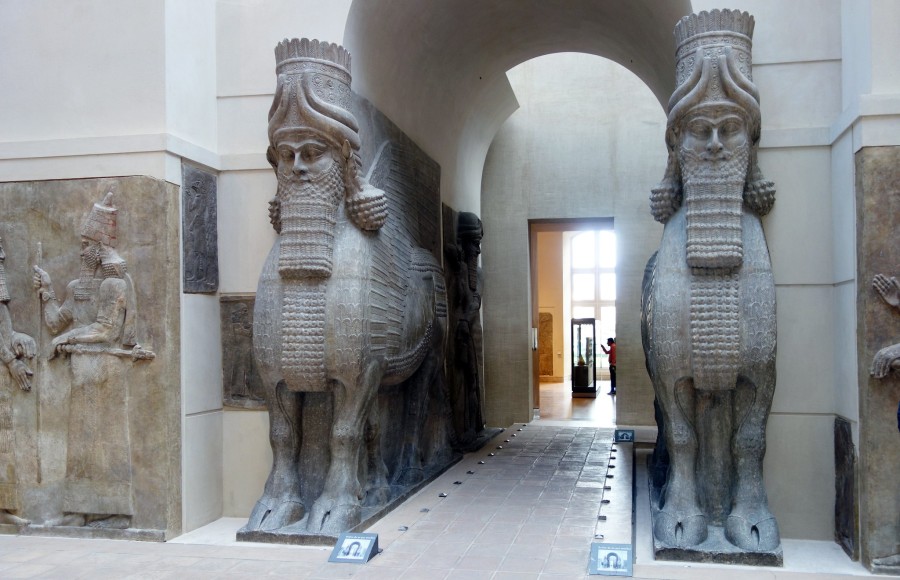
Lamassu were supernatural spirits, sometimes called demons or genies depending on which language you’re translating from, who served to protect the gods, as well as the important human structures. From the ninth to the seventh century BCE, the kings of Assyria ruled over a vast empire centered in northern Iraq. Under the reign of two great Assyrian kings known as Ashurnasirpal II (883-859 BCE) and Sargon II (722-705 BCE), they both established prominent capitals a century apart with a common inclusion of a hybrid mythological guardian creature known as the Lamassu. Lamassu in the Akkadian language means “protective spirits.”
The Iraq museum has several Lamassu statues on display, but the most impressive one is the one from the palace of Sargon II in Khorsabad. It is over 4 meters tall and weighs more than 30 tons. It was carved from a single piece of limestone around the 8th century BCE. The details on the sculpture are incredible: you can see the curls of the beard, the feathers of the wings, and the muscles of the body.
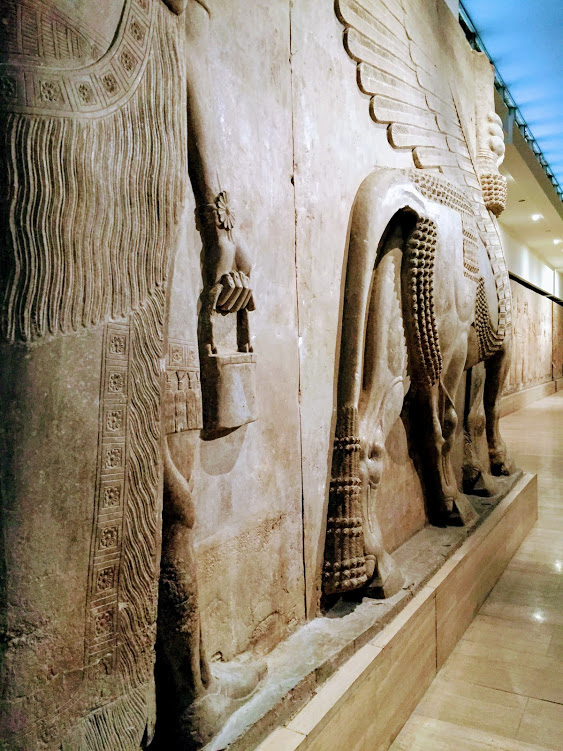
Lamassu is clearly an intriguing creature, but where does it come from? The Lamassu is a celestial being from ancient Mesopotamian religion bearing the head of a man, the wings of an eagle, and the hulking body of a bull, sometimes with the horns and the ears of a bull.
Lamassu frequently appear in Mesopotamian art and mythology. The first recorded Lamassu comes from ca. 3000 BCE. Other names for Lamassu are Lumasi, Alad, and Shedu. The earliest examples of something bearing this resemblance dates back to the Sumerian civilisation of Mesopotamia. The Sumerians recognised a protective deity named Lama, or Lamassu, with a female human form who was a servant of the gods. This protective spirit became very popular in the Assyrian culture of ancient Mesopotamia, and later spread to the Persian Achaemenid Empire (550–330 BCE) as well.
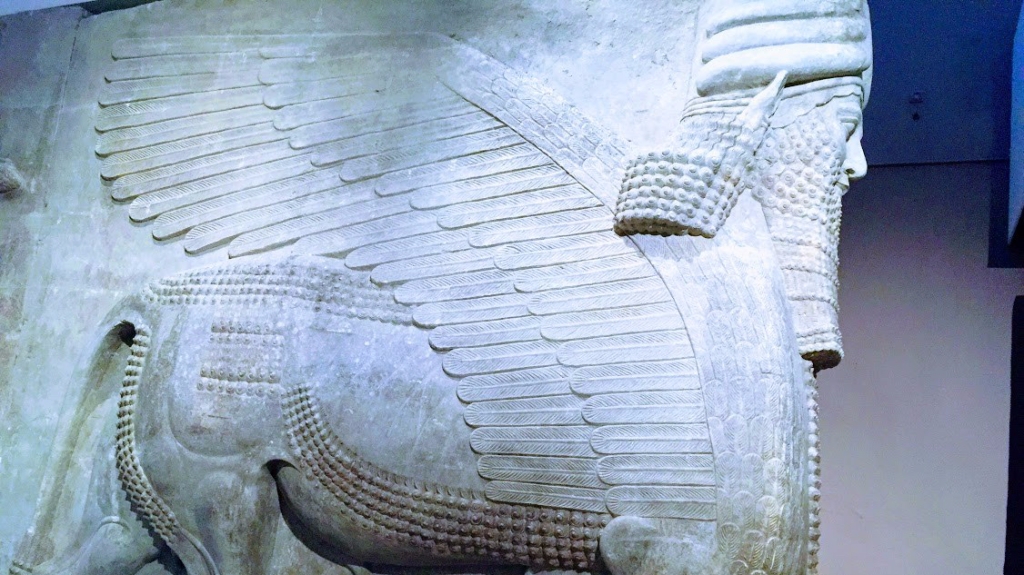
The most famous colossal statues of Lamassu have been excavated at the sites of the Assyrian capitals established by King Assurnasirpal II (reigned 883 – 859 BCE) and King Sargon II (reigned 721 – 705 BCE). The Assyrians envisioned a protective spirit that was part bull and part human (and sometimes part eagle). Instead of being female, this spirit was male, with a nice, long Assyrian beard. It’s worth noting that there was female lamassu as well, which are called “apsasu”.
Ashurnasirpal II, the first great Assyrian king, constructed a new capital in Kalhu (present-day Nimrud) to represent his power and reign over his vast empire. At the entrances to this palace complex, there were hybrid supernatural figures with a bearded human head, the body of a bull or a lion, wings of a bird, and 5 legs that stood guard at all entrances to the palace; this creature is known as the Lamassu, as a protective spirit and a symbol of the power of the Assyrian king. Behind them were colossal winged human figures of the same height, bearing the pine cone and basket – winged genies.
Winged genies are usually bearded male figures sporting birds’ wings. The winged genies are a reappearing trait in ancient Assyrian art and are displayed most prominently in palaces or places of royalty. The two most notable places where the genies existed were Ashurnasirpal II’s palace Kalhu and Sargon II’s palace Dur-Sharrukin (current Khorsabad, Iraq).
 The Assyrian Hall, National Museum of Iraq, Baghdad.
The Assyrian Hall, National Museum of Iraq, Baghdad.
Every important city wanted to have Lamassu protect the gateway to their citadel. At the same time, another winged creature was made to keep watch at the throne room entrance. Additionally, they were the guardians who inspired armies to protect their cities. The Mesopotamians believed that Lamassu frightened away the forces of chaos and brought peace to their homes.
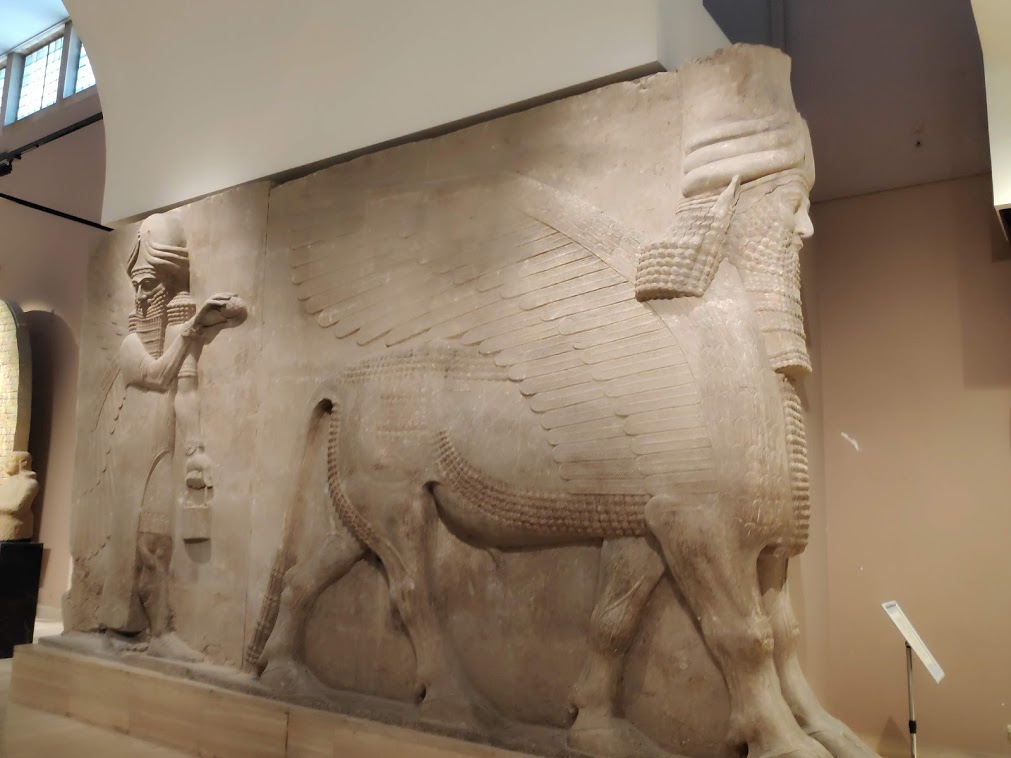
The Lamassu figures are a very interesting example of Neo-Assyrian Art. For several hundred years (934-609 BCE) Assyria was the most important and influential empire in the Mesopotamian region. The kings at this time used art as a way to make certain everyone knew of their importance.
Relief sculpture is by far the most striking manifestation of Achaemenian art. Adopted as the basis of the new style was the straightforward technique of the Assyrians, with its engraved detail and lack of modelling.
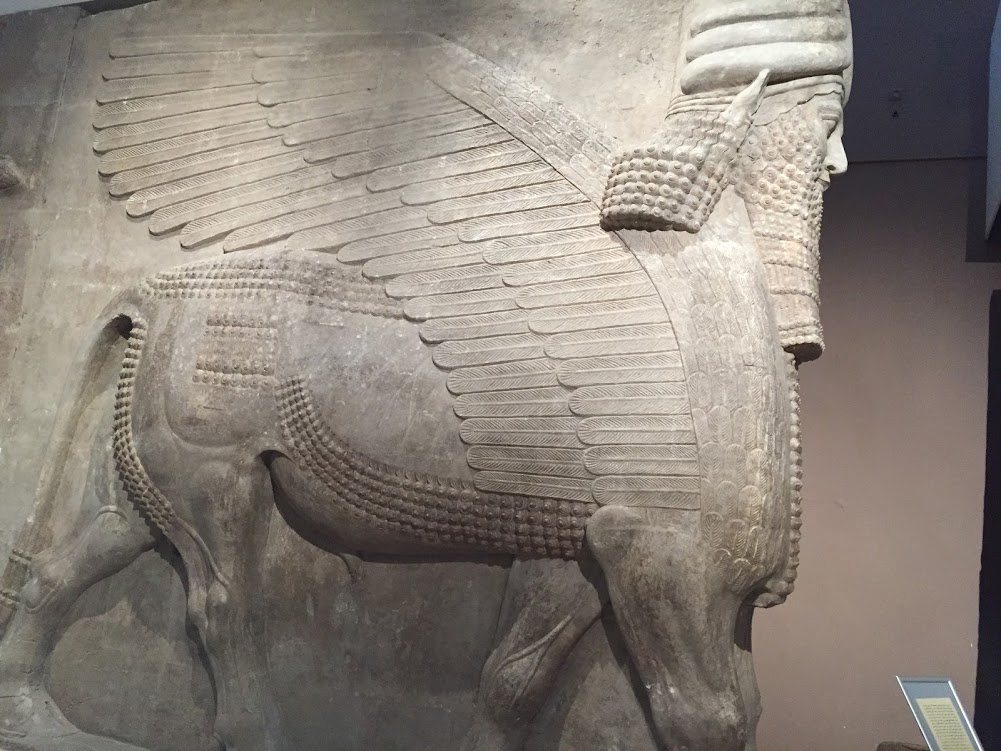 Lamassu: The mythical human-headed winged bull at the National Museum of Iraq, Baghdad
Lamassu: The mythical human-headed winged bull at the National Museum of Iraq, Baghdad
The representation of the human-headed winged bull is the cross of two perspectives, changing from high relief in the flat area (side view) to the full-relief view of the forward portion of the sculpture. The materialisation of the figure emerging from the raw stone block stress the link between creature and palace, as well as dynamic power and motion to the visitors, and thus intended to guard and protect against evil powers. The precarious balance between the motionless posture of the forward-looking portion and the dynamic movement of the side view originates a sedate unsteadiness bringing the creature to life.
The sculptures were meant to be seen in one of two ways – from the front looking directly at the face, or from the side as the viewer entered the king’s throne room. Therefore the figures are sculpted with five legs – two legs that can be seen from the front view and four legs that can be seen from the side. This would indicate that the figure was a four-legged beast, but the extra leg was added so that the side view made visual sense. The figures were carved in relief, that is they were not free-standing sculptures but rather only part of the figure was carved and they needed a wall to support them.
Every important city wanted to have Lamassu protect the gateway to their citadel. At the same time, another winged creature was made to keep watch at the throne room entrance. Additionally, they were the guardians who inspired armies to protect their cities. The Mesopotamians believed that Lamassu frightened away the forces of chaos and brought peace to their homes. The most famous colossal statues of Lamassu have been excavated at the sites of the Assyrian capitals established by King Assurnasirpal II (r. 883 – 859 BCE) and King Sargon II (r. 721 – 705 BCE).
The Akkadians associated the human-bull hybrid as a gatekeeper associated with the god Papsukkal, who is the attendant deity of Anu (sky god of the supreme deities) and functions as a gatekeeper in the spiritual world by providing a pathway between the higher gods and humans. While these hybrid creatures were supernatural beings, they were superior to humans but were not considered to be deities. Even though the Lamassu does wear a horned cap/tiara, which proves their divinity, they were not considered deities in their culture.
After the Assyrians, the Achaemenid Empire of Persia also widely embraced this figure and its protective function. The Lamassu – a symbol combining man, bull, and bird – combines the strength of a bull, the freedom of an eagle, and the intelligence of a human being.
I was awestruck by the sight of this majestic creature. It made me feel like I was transported back to ancient times, when Mesopotamia was the cradle of civilization. I learned so much about the history and culture of this region from the museum guides and the informative panels. The Iraq museum is definitely a must-see for anyone who loves archaeology and art.